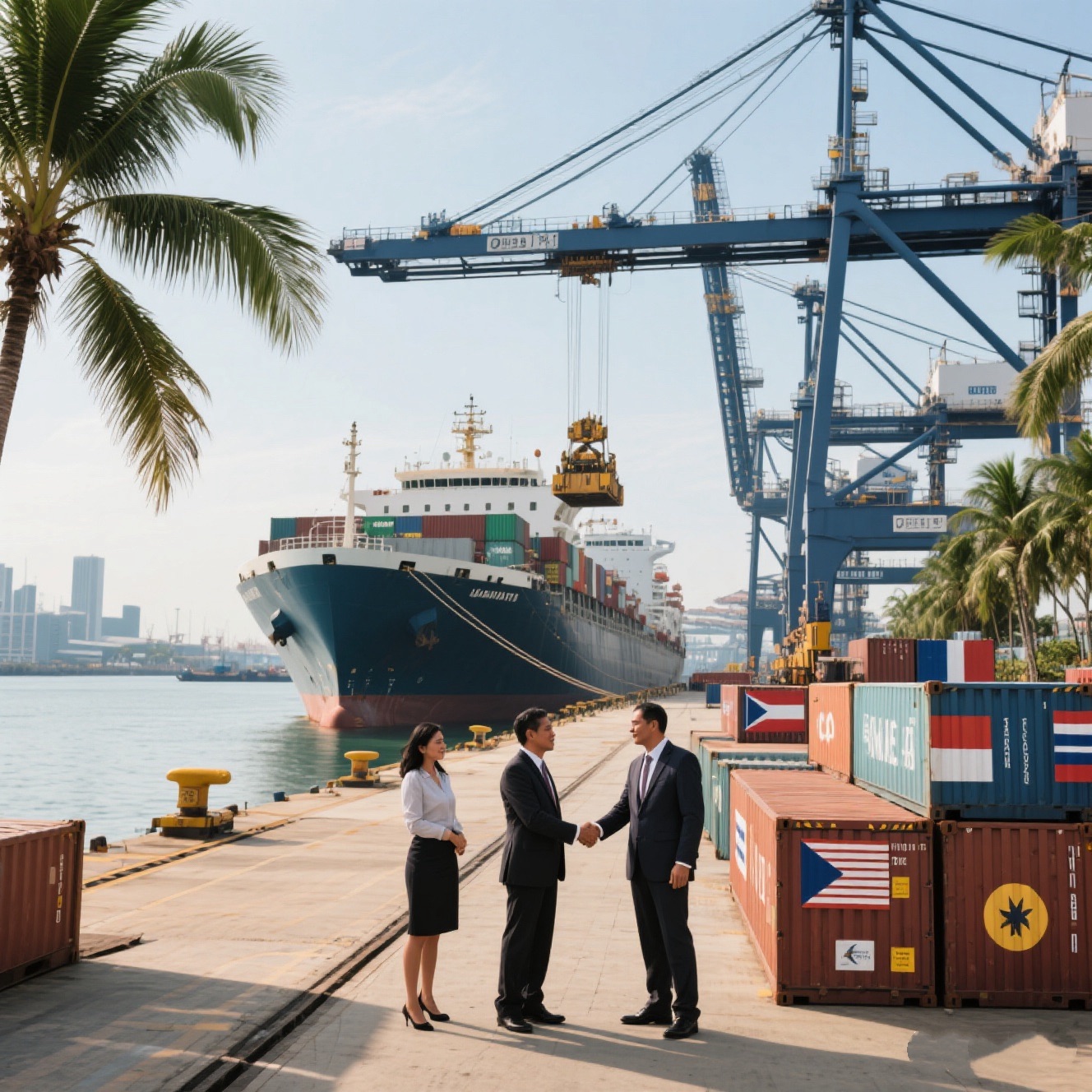
New Opportunities in the Central Asian Market: Strategic Positioning and Practical Guide Amid Energy, Infrastructure, and Policy Dividends
“The rumble of the China-Kyrgyzstan-Uzbekistan railway and the multimodal transport on the shores of the Caspian Sea, the top-level design of the China-Central Asia Summit and the full-chain facilitation of corporate investment – a regional economic transformation driven by resources, infrastructure, and policies is underway.”
The rumble of the China-Kyrgyzstan-Uzbekistan railway and the multimodal transport on the shores of the Caspian Sea, the top-level design of the China-Central Asia Summit and the full-chain facilitation of corporate investment – a regional economic transformation driven by resources, infrastructure, and policies is underway. This once-neglected Eurasian hinterland is integrating into the global trade system at an astonishing speed, bringing unprecedented opportunities to perceptive foreign trade enterprises.
01 A New Phase in Energy Cooperation: From Resource Export to Full Industrial Chain Integration
*Resource Endowment and Market Position*
The Central Asian region is rich in energy resources, and the depth and breadth of its cooperation with China continue to expand, upgrading from traditional trade relations to full industrial chain collaboration. Kazakhstan's proven oil reserves reach 4.8 billion tons, and its crude oil production exceeded 90 million tons in 2023, accounting for 2.1% of global total output. The China-Kazakhstan crude oil pipeline, as the most important energy channel in China's northwest direction, has an annual transmission capacity of 20 million tons, and the cumulative volume of oil delivered has exceeded 150 million tons, equivalent to 15 days of China's crude oil import demand.
*New Landscape in Natural Gas Cooperation*
Natural gas cooperation is a highlight of the energy partnership between the two sides. Turkmenistan's proven natural gas reserves account for 8.9% of the global total, making it the primary source for the China-Central Asia natural gas pipeline. The four existing pipelines (A/B/C/D) have cumulatively delivered over 400 billion cubic meters of gas, equivalent to 1.2 times China's annual natural gas consumption, benefiting 500 million people in 27 Chinese provinces, autonomous regions, and municipalities. The new natural gas supply agreement signed in 2024 increases the annual supply volume to 65 billion cubic meters, further consolidating Central Asia's position as a crucial pillar of China's energy security.
*Deep Industrial Chain Integration*
The cooperation model is undergoing a qualitative leap: Chinese companies are no longer limited to energy trade but are deeply involved in the entire chain, including upstream exploration and development, midstream transportation, and downstream processing. In Kazakhstan, the modernization project of the Shymkent oil refinery involving Chinese companies increased local refined oil processing capacity from 60% to 90%, reducing annual refined oil imports by 3 million tons. In Turkmenistan, the development project of the right-bank gas field of the Amu Darya involving Chinese companies increased production capacity by 30% and created over 5,000 local jobs.
*New Energy Cooperation Opportunities*
In addition to traditional energy, new energy cooperation has also seen breakthroughs. Kazakhstan plans to increase the share of renewable energy generation to 15% by 2030, bringing huge business opportunities for Chinese photovoltaic and wind power enterprises. The memorandum on new energy cooperation signed between China and Kazakhstan in 2024 explicitly outlines deep cooperation in areas such as wind power equipment manufacturing and energy storage technology, with the first batch of projects valued at over $20 billion.
02 Strategic Minerals: A Key Piece in the New Energy Era
*Solid Advantages in Traditional Minerals*
Central Asia is not only an important producer of traditional minerals but also a strategic stronghold contested by the global new energy industry chain. Uzbekistan's annual gold production stably exceeds 100 tons, and it possesses world-class super-large gold mines like Muruntau. Gold exports account for 25% of the country's total export value. Kazakhstan's tungsten reserves account for a quarter of the global total, and its uranium production accounts for 18% of global supply, making it the world's second-largest uranium supplier. Uranium export revenue reached $4.5 billion in 2023.

*Breakthroughs in New Energy Minerals*
More notably are the breakthroughs in new energy minerals. In recent years, lithium exploration in Central Asia has achieved major progress, with initial proven lithium reserves exceeding 1 million tons, which can meet 5% of the raw material demand of the global power battery industry. Kazakhstan's rare earth reserves are approximately 12 million tons, covering core elements for new energy equipment like praseodymium and neodymium. These discoveries make Central Asia an important part of the global new energy industry chain layout.
*Innovative Participation Models for Chinese Companies*
Chinese companies are actively participating in Central Asian mineral development through the full industrial chain model of "exploration + development + processing." Uranium mines developed in cooperation with Kazakhstan account for 70% of its uranium exports to China. The lithium exploration project invested in Uzbekistan plans to achieve mass production by 2025. This cooperation not only ensures resource supply but also drives the upgrading of the local industrial chain. Taking Uzbekistan as an example, the gold smelting project involving Chinese companies increased gold purity from 95% to 99.99%, increasing product added value by over 30%.
*Market Prospects and Risk Tips*
According to industry forecasts, the output value of new energy minerals in Central Asia will triple by 2030 compared to current levels. However, investors should also note that mineral development faces challenges such as insufficient infrastructure and rising environmental standards. It is recommended that enterprises adopt a "gradual investment" strategy, starting with trade cooperation and gradually extending into deep processing.
03 Infrastructure Connectivity: Reshaping Eurasian Trade Routes
*Strategic Significance of the China-Kyrgyzstan-Uzbekistan Railway*
Infrastructure construction is fundamentally changing the economic geography of Central Asia, with the China-Kyrgyzstan-Uzbekistan railway project being the most representative. After completion, this approximately **500-kilometer** railway will reduce the freight time from China's Xinjiang to Uzbekistan from 25-30 days to 15-18 days, cutting transportation costs by 30%. The project is expected to commence full-scale construction in July 2025 and be completed and open to traffic within 4 years, with related engineering contract values exceeding $20 billion.

*Upgrading Regional Transportation Networks*
Regional transportation networks are upgrading from "point-to-point connectivity" to "multimodal transport." Kazakhstan, as the "railway hub" of Central Asia, handled 29 million tons of transit freight in 2023, a year-on-year increase of 12%. The middle route of the China-Europe Railway Express operated over 3,000 trips annually, becoming a stable channel for Eurasia trade. After Uzbekistan completed the electrification renovation of the "Tashkent-Samarkand" railway, freight speed increased from 60 km/h to 120 km/h, doubling transport capacity.
*Improving Multimodal Transport Systems*
The multimodal transport system is continuously improving. Kazakhstan, relying on Caspian Sea ports, is creating a new route of "China – Kazakhstan Railway – Caspian Sea – Iran/Turkey Sea Transport," with freight volume exceeding 500,000 tons in 2023. The road-rail combined transport line "Tashkent-Peshawar" opened through cooperation between Uzbekistan and Pakistan reduces the time for Central Asian goods to enter the South Asian market by 40%. This model of coordinated "rail-road-port" effort is rewriting the regional logistics landscape.
*Infrastructure Investment Opportunities*
In addition to large projects, there is also strong demand for livelihood infrastructure. Uzbekistan plans to renovate 60% of its rural roads (total mileage over 10,000 km) in the next five years; Kazakhstan needs to build new 500-kilovolt transmission lines to connect northern oil fields with southern industrial zones. The contract value for individual projects mostly ranges from $100 million to $500 million, suitable for participation by small and medium-sized engineering enterprises.
04 Continuous Release of Policy Dividends: Continuously Optimizing Investment Environment
*Trade Facilitation Measures*
The improvement of top-level design provides institutional guarantees for economic and trade cooperation. China and Central Asian countries have signed multiple cooperation documents through summit mechanisms, promoting the implementation of trade facilitation measures. The customs "single window" has achieved partial data connection with Kazakhstan and Uzbekistan, reducing enterprise declaration time from 2 hours to 40 minutes. The pilot "regional customs integration" realizes "one declaration, one inspection, one release," significantly improving cross-border trade efficiency.
*Investment Support Policies*
Investment facilitation measures continue to be enhanced. A "China-Central Asia Cooperation Fund" of over **$10 billion** has been established, focusing on supporting energy deep processing, logistics parks, cross-border e-commerce, and other projects, with loan interest rates 1-2 percentage points lower than international markets. Uzbekistan implements "one-stop approval for investment projects," which can be completed within 7 working days. Kazakhstan has opened a "fast track" with EIA exemptions for high-tech projects, reducing approval time by 60%.
*Visas and Personnel Exchanges*
Visa policy relaxation promotes personnel exchanges. China and Kyrgyzstan, as well as China and Uzbekistan, have mutual visa exemption for group tours; China and Kazakhstan have opened a fast track for business visas. In 2024, Chinese tourists visiting Central Asia reached 1.8 million, recovering to 1.5 times pre-pandemic levels. The increase in personnel exchanges has spawned investment opportunities in service industries such as hotels, catering, and retail, with the occupancy rate of Chinese-funded hotels in Samarkand consistently remaining above 85%.
*Risk Prevention Mechanisms*
To protect investor rights, China and Central Asian countries have signed new versions of investment agreements and established an "investment dispute arbitration mechanism." The investment risk compensation fund established through China-Kazakhstan cooperation provides up to 50% coverage for non-commercial risks for enterprises investing in Kazakhstan. These measures significantly reduce investment risks for enterprises.

05 Corporate Investment Strategy: Seizing Opportunities in Specific Sectors
*Investment Advice in the Energy Sector*
For enterprises planning to enter the Central Asian market, there are significant opportunities in the energy deep processing sector. Central Asian countries are promoting local resource processing, with strong demand in areas like oil and gas refining and mineral purification. The gold purification project in Uzbekistan increased product added value by over 30%, and similar opportunities exist in multiple fields. It is recommended that enterprises adopt a "technology + capital" export model, exchanging advanced technology for market access.
*Entry Points in the Infrastructure Market*
In the infrastructure construction sector, besides participating in large projects, attention can be paid to emerging areas such as smart ports and new energy supporting infrastructure. The current informatization level of existing ports in Central Asia is relatively low. Chinese companies can provide integrated solutions like "customs inspection systems + intelligent gates + data exchange platforms." The smart transformation project of the China-Kazakhstan "Jeminay" port, which has been participated in, improved clearance efficiency by 50%. This model can be replicated at 12 major cross-border ports in Central Asia.
*Timing for Layout in Emerging Industries*
With the development of resources like lithium and rare earths, industries such as new energy materials and battery manufacturing are ushering in opportunities for layout. Kazakhstan plans to achieve new energy vehicle production of 50,000 units by 2025 and has launched a series of preferential policies for this, including a 5-year tax holiday and land subsidies. It is recommended that relevant enterprises pay attention to investment promotion policies in local industrial parks and adopt a "light asset" model for initial pilot projects.
Practical Suggestions for Market Expansion
1. Localized Cooperation: Choosing local partners with government backgrounds can effectively avoid policy risks.
2. Financing Channels: Make full use of low-interest loans from policy banks and cooperation funds.
3. Talent Strategy: Hire local employees for daily operations management, and assign expatriates responsible for technical management.
4. Risk Prevention and Control: Insure export credit insurance to avoid payment risks.
As of 2024, the cumulative contract value of projects contracted by Chinese enterprises in Central Asia reached $120.1 billion, covering transportation, energy, municipal administration, and other fields. With the acceleration of regional integration, the Central Asian market is transforming from a "corridor" to a "hub." In the next five years, infrastructure investment demand in the region will exceed $300 billion, providing a rare development window for forward-looking enterprises.
For foreign trade enterprises, the current period is critical for laying out the Central Asian market. It is recommended that enterprises combine their own advantages, select suitable entry fields, make full use of policy dividends, and seize the initiative in this promising market.












